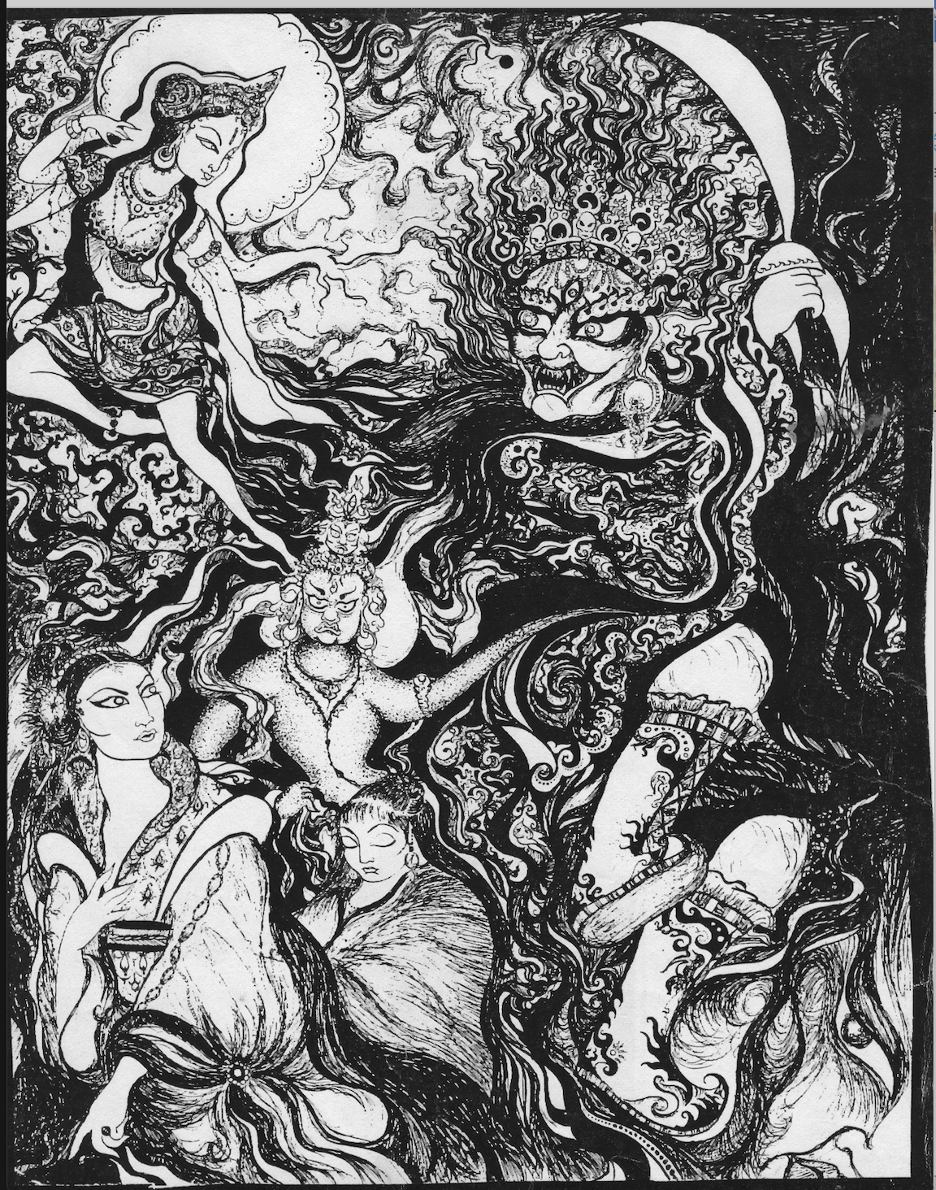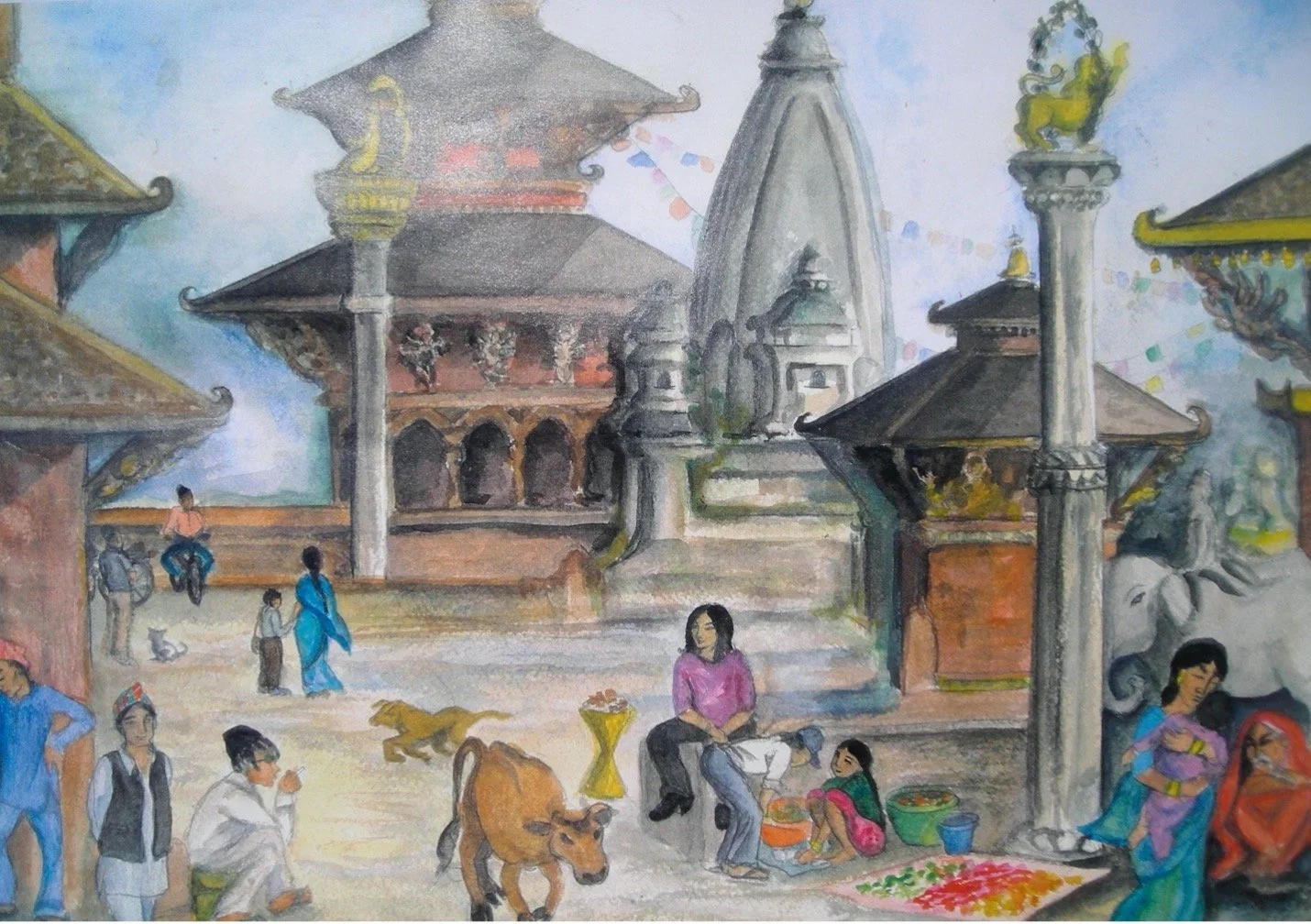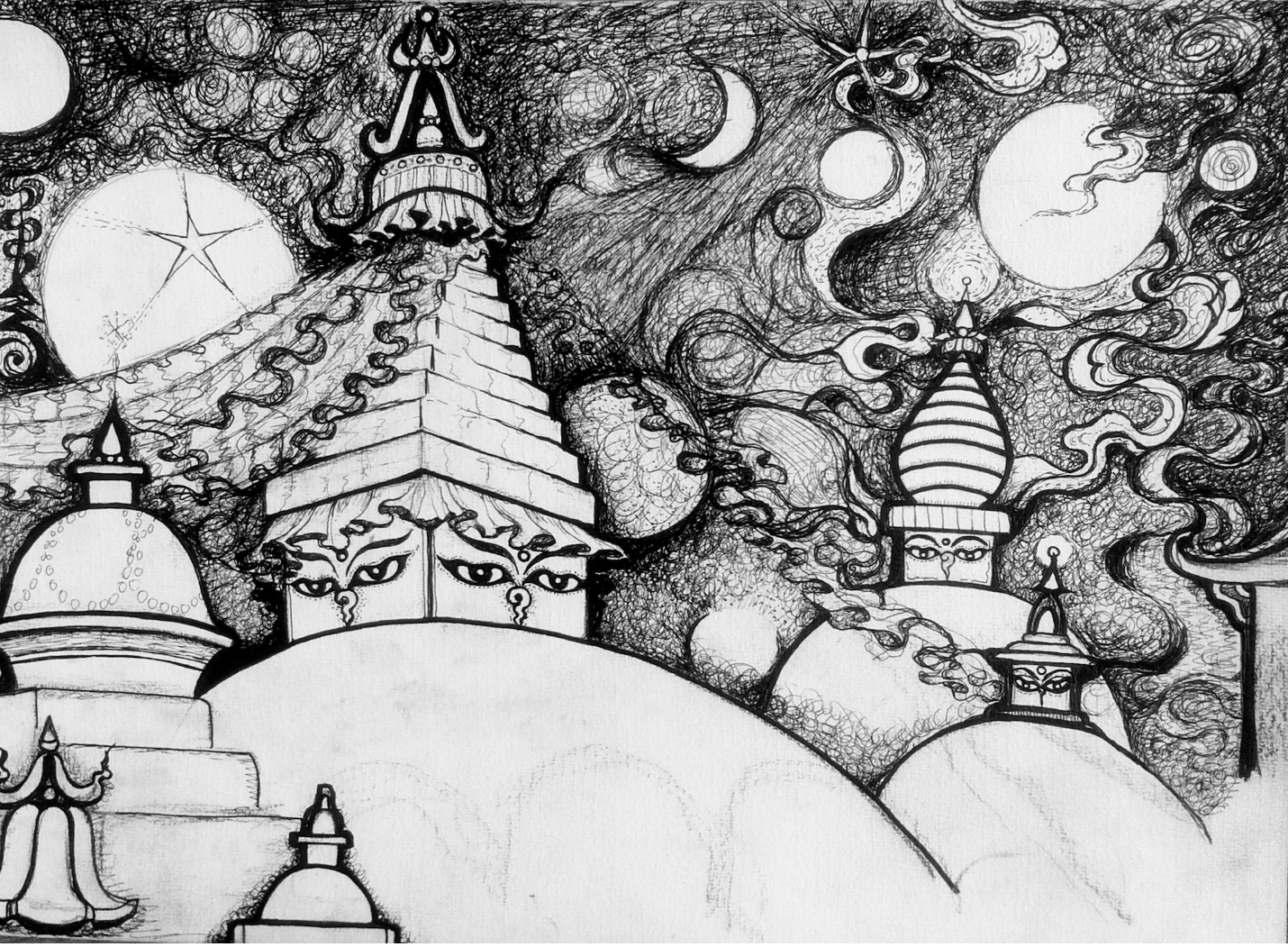Kathmandu, Nepal - The Lotus Valley of the Naga Kings
Artwork and text by Maura Moynihan
From “POWER PLACES OF KATHMANDU” by Keith Dowman
“In Hindu mythology the Himalayas have always been the abode of the gods. The remoteness of the mountains, their awesome majesty, and the symbolic significance of their immutable mass have all contributed to their aura of divinity. In the lap of these mountains lies the Kathmandu Valley, a landscape charged with the presence of the divine. In this fertile and temperate valley, the Hindu and Buddhist traditions of Nepal recognize numerous power places -- focal points of divine energy -- where humans can make contact with the realm of the gods. Geomantic forces, divine myth, and human legend and history, combine to make these locations potent sources of spiritual revitalization and psychic renewal.”
How I Discovered Nepal
When I was 15, I arrived in New Delhi with my family, and like before and after me, I fell under the spell of India, and Kathmandu, Nepal, the Lotus Valley of the Naga Kings.
Arrival at Roosevelt House, New Delhi, India, 1973, with my brother John and my father Ambassador Daniel Patrick Moynihan.
We first visited Nepal in the summer of 1973, fleeing the torrid heat of New Delhi for the lush and verdant Hindu Kingdom. In those days there were few motor vehicles, cows, goats and buffalos wandered freely through the streets, snow peaks of the Himalayas gleamed above the green hills that encircled Kathmandu Valley. Nepal is no more a kingdom, and Kathmandu is now a teeming metropolis choked with smog and traffic, where a glimpse of Himalayan peaks is a rarity. But Kathmandu was the city I loved best in all the world, for it is filled with artisans, shamans, lamas and pujaris who perform the complex, ornamental rituals of daily life, as they have for thousands of years. Kathmandu an ancient place of pilgrimage, where Hindu and Buddhist temples and stupas blend in the Vajrayana culture of the Newari people, the valley’s ancestral inhabitants, the Bhumiputris of valley.
The Vedic Universe, pen & ink, inspired by my first trip to Kathmandu
“Painting is just another way of keeping a diary.” Pablo Picasso
I returned to India and Nepal to live and to work over 5 decades. I always carried paint, brushes, pencils and paper, and watercolors – they dry quickly, suitable for keeping a diary. I journeyed to Thailand, Bhutan, Sikkim, Ladhak, Tibet, China, Japan, Iran, Afghanistan, Uzbekistan, Pakistan, Bangladesh, Sri Lanka, Laos, Cambodia and Burma. Everywhere I saw seeds of Hinduism and Buddhism fertilized in the rich and varied lands of Southeast Asia, East Asia, Tibet, Ladakh, Nepal, Sikkim, Bhutan and Arunachal Pradesh. And most especially in the anchor of the Himalayan Belt, Nepal.
For 5 years I rented a house in Kathmandu, in the late 90’s into the early 2000’s. I had a day job as a journalist but spent a portion of every day sketching and painting. There was always so much to paint, to admire, every day you could discover another temple and stupa, or wander into a jatra, the Newar festivals. Kathmandu is known to have more religious festivals and holidays than any capital city in the world – at least one a day, often several in a day.
Yoga Hotel - my first musical album, inspired by Kathmandu
https://www.amazon.com/Yoga-Hotel-Maura-Moynihan/dp/B003VNGMW8
Painting at Pashupatinath, the Shiva Temple, and Jorpati, above Boudha Stupa
Nepal, Land of Buddha and Shiva
The political delineation of the state of Nepal is a slim slice of 147,181 square kilometers which contains one of the world’s oldest civilizations in an ecosystem reaching from Mount Everest to the Gangetic Plains of India. The Buddha was born a Sakya prince in Lumbini, Southwestern Nepal, in about 563 BC, thus Nepal is a holy land to all Buddhists. From Nepal’s many mountains flow the healing waters of the Himalaya, home of Lord Shiva, thus Nepal is a holy land to all Hindus. Nepal is an ancient portal to the Silk Road, linking India and Tibet, its trade routes, towns and temples weaving the distinctive culture of the Himalayan Belt, once a chain of independent kingdoms and nomad pastures encircling the southern shelf of the Tibetan plateau. If you wish to work in Kathmandu, you must observe the Vedic Bikram Sambat calendar with its intricate maze of festivals and auspicious and inauspicious days, or you won’t get anything done. Today one may find ATM machines and Internet cafes in central Kathmandu, but it is still a place where a Brahma Bull will wander into rush hour traffic and lie down for a lengthy nap, holding the World Bank motorcade hostage for as long as he wishes.
Samsara
Sri Laxmi Devi
Afternoon in Lalitpur
I loved Kathmandu’s monsoon festivals: Teej, Janmasthami, Gunla, Labab Duchen, Gai Jatra. The ladies of Kathmandu are ever exquisitely attired in red, gold and pink saris, gold and silver jewelry, flowers and tinsel woven into silken hair, eyes painted with kajal, hands with mehndi.
Mandirs of the Valley
Durbar Square
Asan Tol and Basantapur
A corner of Tainti
Keith Dowman, “Power Places of Kathmandu.”
“In the environs of Kathmandu, the ancient traditions of goddess worship, animism, and shamanism have for centuries coexisted with the high cultures of Buddhism and Hinduism, both orthodox and tantric, to create a religious culture of rich diversity, vigor and complexity. The power places of the valley range from simple unhewn rocks and boulders revered since ancient times, to impressive pagoda temples replete with wood, bronze and stone sculptures. These sacred places where the energies of heaven mingle with the affairs of earth have been the goal of devout pilgrims from different spiritual traditions down through the ages.'
Boudha by starlight
I was forever entranced by Boudha Stupa, one of the largest stupas in the world, a sacred place of pilgrimage from time immemorial. Fragments of old Tibet lived on in the pilgrim stream that spun day and night like a prayer wheel around the holy site, and in the medieval town which surrounded the holy mound with winding lanes, shops with thangkas, chubas, prayer flags and prayer beads, monks and nuns, Khampas, Amdowas, Utsangbas, Managis, Sherpas, Gurungs, Tamangs, pilgrims from Bhutan, Sikkim, Ladakh, India. Drums, horns, cymbals, mixed with bird calls and Hindi film songs, sage burned in tin cans dangling by the gompa doorways, within the monasteries rows of monks immersed in puja to Lord Buddha, Tara, Manjushri, Yamantaka, Guru Rinpoche and Ajima Ma, the Newar Goddess, protector of children and of Kathmandu Valley.
Boudhanath, The Jewel in the Lotus
Kathmandu Guest House – the Newar Garden
Kathmandu Guest House – the Newar Garden
Taleju Mandir, Basantapur
Temple of Taleju Bhwani, royal Goddess of the Malla Dynasty.
Taleju Mandir is only open for public worship once a year, during the autumn Dasain Festival, the longest and the most auspicious festival in the Bikram Sambat and Nepal Sambat calendar, celebrating Goddess Durga’s victory over Mahishasura, the Buffalo Demon.
Svayambunath Stupa, where Bodhisattva Manjushri drained the primordial lake, subdued the Naga Kings and established the Buddhadharma in Kathmandu valley.
My garden in Kamalpokhari.
I loved Kathmandu in winter, the morning fog dissolving by into sunlight, the evening haze fading into a weave of pink, blue and grey with a languid red sun sinking below the brim of Nagarjuna mountain, the cold, black night wrapped in stars and warmed by bonfires. My mali, the gardener Cool Bahadur, appeared every morning at 6 AM, rain or shine, floating through the garden with his watering can and trowel, intoning mantras and Hindi film songs, his black topi titled to the left and his magicians’ hands, which could conjure a jungle from a weary patch of soil. He would wave from his stool, smoking bidis and sipping tea, as the mystical fog of a Kathmandu dawn vanished by imperceptible degrees.
Somewhere in Thamel
Nepali entrepreneurs have reinvented Kathmandu nightlife, which for decades was choked by tacky casinos. Thamel, the tourist hub, now teems with French and Italian bistros with imported Chianti, wi-fi coffee bars, and at last, proper discos, open till dawn.
Sri Shyamatar, Tara Sengdeng Nganchi.
Kathmandu Valley’s religion is woven from animistic worship of the spirits, and most abiding, worship of the Mother Goddesses, the 21 Taras of Buddhism, and the Adi Shakti Goddess of Hinduism.
Rabzima Ma, Tara of Purification, and Goddess Maha Kali
Taras Zhengyi Migyalma, Ozer Chenma, Rito Loma Jonma, Pagme Nonma
MY MUSIC VIDEO of my song MAHADEVI KI NAM filmed in Kathmandu by Tsering Rhitar

























